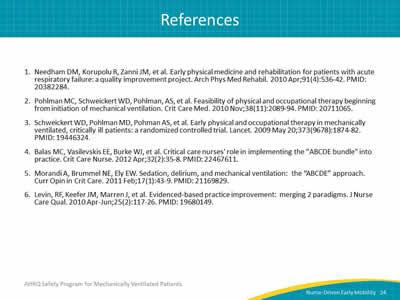Nurse-Driven Early Mobility Protocols: Facilitator Guide
AHRQ Safety Program for Mechanically Ventilated Patients
Slide 1: Nurse-Driven Early Mobility Protocols
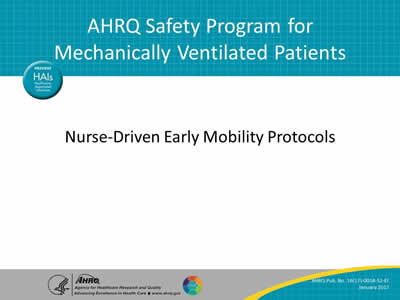
Say:
This module will provide an overview of the interventions required for early mobility in mechanically ventilated patients and ways to establish and sustain a nurse-driven early mobility protocol.
Slide 2: Learning Objectives
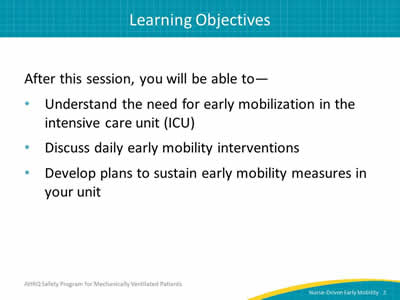
Say:
After this session, you will be able to explain why early mobilization of patients is important and be able to discuss when and how to implement daily early mobility interventions. In addition, you will learn strategies to sustain early mobility measures in your unit.
Slide 3: Early Mobility
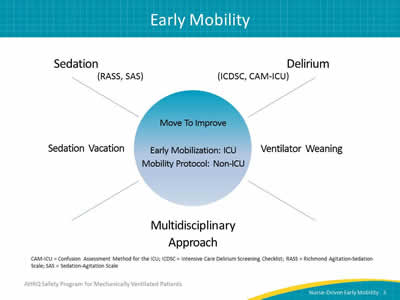
Say:
Image: Graphic illustrating the relationship of three aspects of early mobility (sedation, delirium, multidisciplinary approach). Within the circle at the center is the text "Move To Improve, Early Mobilization: ICU, Mobility Protocol: Non-ICU"; around the circle are four quadrants captioned with the following text: Sedation: (RASS, SAS), Delirium: (ICDSC,CAM-ICU), Sedation Vacation. Ventilator Weaning. Multidisciplinary Approach. CAM-ICU = Confusion Assessment Method for the ICU; ICDSC = Intensive Care Delirium Screening Checklist; RASS = Richmond Agitation-Sedation Scale; SAS = Sedation-Agitation Scale.
Slide 4: Scope of Problem
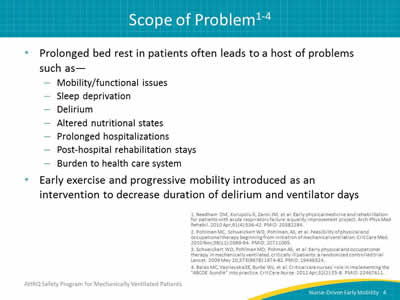
Say:
Prolonged bed rest in patients often leads to a host of problems such as: mobility and functional issues, sleep deprivation, delirium, altered nutritional states, increased hospital and post-hospital rehabilitation length of stay, and an overall burden to the health care system. To address these problems, early exercise and progressive mobility have been introduced as an intervention to decrease duration of both delirium and ventilator days.
Slide 5: Purpose and Goals
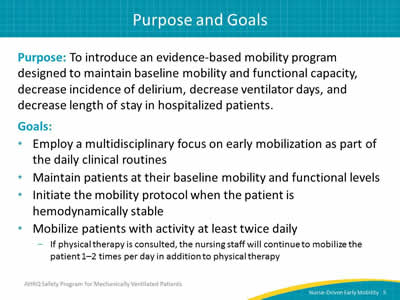
Say:
The purpose of early mobility is to introduce an evidence-based mobility program designed to maintain baseline mobility and functional capacity, decrease the incidence of delirium, and decrease ventilator days and hospital length of stay. The goals of nurse-driven early mobility are to promote a multidisciplinary focus on early mobility as part of the daily clinical routines, maintain patients at their pre-hospital baseline mobility and functional levels as much as possible, initiate a mobility protocol when the patient is hemodynamically stable, and mobilize the patient with an activity at least twice a day.
Slide 6: Early Mobility Interventions
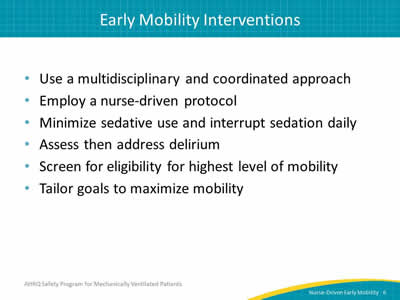
Say:
Early mobility interventions necessitate a coordinated approach with a multidisciplinary team. Your multidisciplinary team might consist of nurses, a respiratory therapist, a physical therapist, a clinical pharmacist, an occupational therapist, and a physician. This coordinated approach includes the employment of a nurse-driven protocol to get the patient out of bed faster. In order to mobilize patients sooner, sedation levels need to be reduced to keep patients lightly sedated at most. Then, spontaneous awakening and spontaneous breathing trials, or SATs and SBTs, should be performed. Once sedations have been interrupted, any signs of delirium must be assessed and then addressed. In addition, patients need to be screened to determine their eligibility for the highest level of mobility. Finally, tailor patient goals to maximize mobility.
Slide 7: Early Mobility: Improved Outcomes
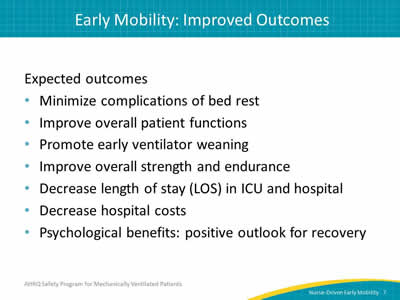
Say:
Mobilizing patients sooner can lead to improved patient outcomes. The use of an early mobility protocol should minimize complications of bed rest, improve patients' overall functions, promote ventilator weaning in a timely manner, improve patients' overall strength and endurance, and decrease ICU and hospital lengths of stay, which in turn lead to a decrease in hospital costs. Finally, the psychological benefit for the patient from early ambulation cannot be overlooked.
Slide 8: Implementation of the ABCDE Bundle
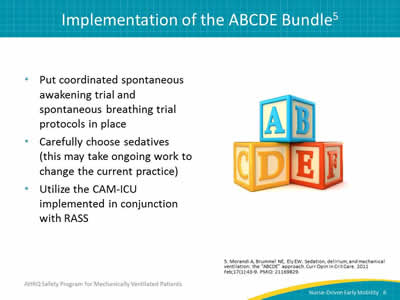
Say:
Implementation of the ABCDEF bundle refers to conducting spontaneous awakening trials and spontaneous breathing trials; choosing light sedation by decreasing the use of benzodiazepines and targeting alertness, delirium monitoring, and management; and implementing early exercise and mobility. The addition of the F component is more recent, and it encourages family involvement in care. Though we will not discuss this aspect in detail here, keep family participation in mind whenever possible with early mobility initiatives.
Slide 9: Continued Progress
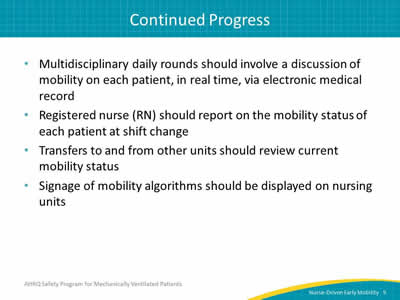
Say:
Some steps you can take to continue your progress of early mobility in your unit may be to discuss the mobility status of each patient in real time during multi-disciplinary rounds. Mobility status of patients can also be discussed during shift-to-shift reporting and when patients are transferred to or from other units. As visual reminders, algorithms for mobility can also be posted in each unit. A mobility protocol can be part of the new employee orientation for appropriate staff members.
Slide 10: ICU Early Mobility Screening Algorithm
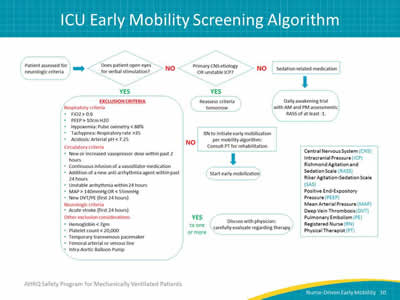
Say:
Using a tool to help screen for the appropriateness of early mobility helps determine whether a patient is clinically ready to attempt early mobilization. This algorithm begins by reviewing the neurological criteria: Does the patient open his or her eyes in response to verbal stimulation? If the patient does not meet the neurological criteria, you must next determine whether it is due to a primary central nervous system, or CNS, etiology or unstable intracranial pressure, or due to a sedation-related medication. If there is a primary CNS etiology or unstable intracranial pressure, the patient should be reassessed the following day. If the patient does not open his or her eyes to verbal stimulation due to the use of sedation-related medication, daily awaking trials should be performed in the morning and afternoon with the goal of achieving a RASS score of at least negative one. If these measures do not succeed in arousing the patient sufficiently, the patient should be reassessed the following day.
If the patient does meet the neurological criteria, he or she must then be assessed against exclusion criteria for respiratory, circulatory, neurologic, and other considerations as shown in the exclusion box on the flow chart. If the patient clears the exclusion criteria, a registered nurse (RN) may carefully initiate early mobilization in conjunction with a physical therapist. If the patient clears some, but not all, exclusion criteria, the nurse should discuss the appropriateness of beginning activity with the physician.
Slide 11: ICU Early Mobility Protocol
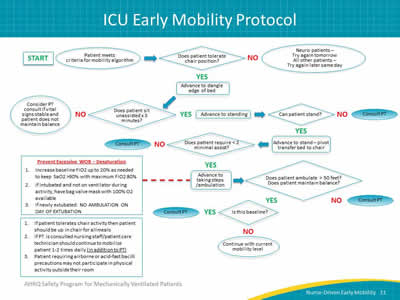
Say:
This flowchart illustrates an ICU mobility protocol. The flowchart guides the care team through the progression of stages the patient progresses through to achieve maximum mobilization. When the patient begins to mobilize, if they are not at their baseline activity or if they do not progress through the algorithm as anticipated, the nurse has the authority to consult physical therapy (PT) and occupational therapy (OT) when appropriate. When a physician orders the mobility protocol, he is giving the nurse the tools needed to access the patient and to order PT and OT when he or she feels it is warranted. This protocol also encourages and enables collaboration with respiratory therapy to improve mobility.
Slide 12: Intermediate Care Unit
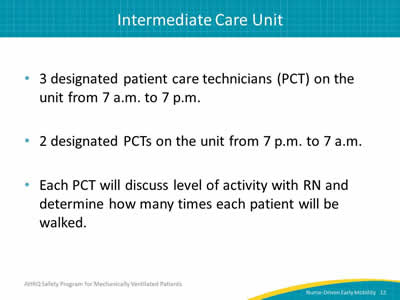
Say:
Here is an example of a hypothetical intermediate care unit’s patient care technician (PCT) team plan. Three designated patient care technicians who collaborate with the nurses work from 7 a.m. to 7 p.m. Each PCT has eight patients. The nurse-to-patient ratio might be one to three or one to four, but it is the patient care technician who is responsible for mobilizing that patient, or patients, during a 12-hour shift. Patients are also mobilized in the evening, so there are two designated patient care technicians on the unit from 7 p.m. to 7 a.m. Each patient care technician will discuss the patients’ level of activity with the RN at the beginning of their shift and determine how many times patients will be mobilized throughout the day.
Slide 13: Mobility Techs
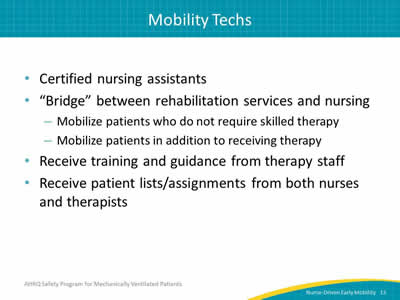
Say:
Consider establishing a mobility technician ("tech") program. Certified nursing assistants can be the mobility techs who act as a bridge between nursing and physical or occupational therapy. They can mobilize any patient that PT determines does not require any skilled therapy or more than minimal assistance to mobilize. Frequently, nurses have so many tasks to accomplish during the day that they do not have time to mobilize their patients. By partnering with the nursing and PT staff to create a mobility tech program, mobility techs can assist in the early mobilization of patients.
Slide 14: Mobility Tech Data
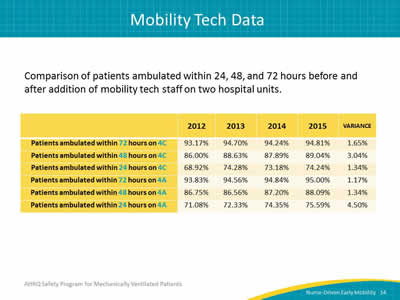
Say:
This chart shows a comparison of patients in two units who were ambulated within 24, 48, and 72 hours before and after the addition of a mobility tech staff. There is an improvement in the percentage of patients mobilized from pre-implementation baseline and the end of the program in 2015, at which point the mobility tech staff had been established for 3 years.
Slide 15: Framework to Guide Your Program
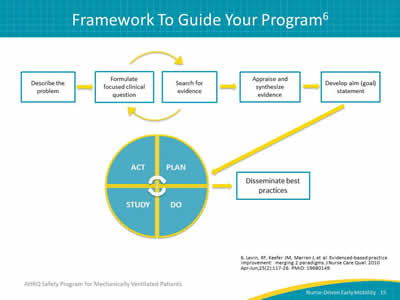
Say:
The Evidence-Based Performance Improvement Model can be used as a framework to guide you through the process of describing the problems you are encountering with mobilizing your patients and reviewing the evidence to see what can be done to increase mobility and improve patient outcomes. Synthesizing the evidence and then working on implementation changes is known as the PDSA (plan, do, study, and act) method.
Slide 16: Small Tests of Change
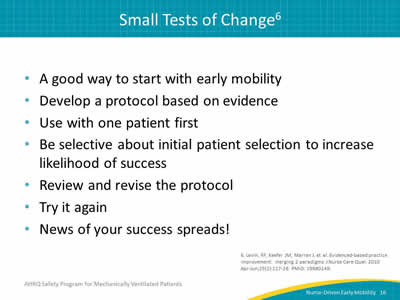
Say:
Part of this PDSA model is called Small Tests of Change. Think of a small change or improvement you would like to initiate in your unit. Develop and disseminate your protocol and "test out" this change with one patient, one nurse, one respiratory therapist, one physical therapist, or one physician and see if the change you want to implement is effective. Does the wording make sense to everyone? Is it clearly written and easily understood? If it is not effective, review what you have done, revise if necessary, and try again. Be selective with the initial change you make so you can be successful and move on to the next change.
Slide 17: Measurement of Outcomes
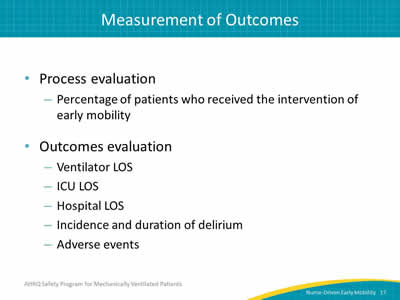
Say:
Measuring patient outcomes is an important part of assessing whether your early mobility program is effective. First, there is process evaluation, which is a means of determining whether you have effectively implemented a program. For instance, if the goal is to mobilize more patients in your ICU, you may choose to look at the percentage of patients who received the early mobility intervention and determine if that number has met your definition of a successful outcome. Second, there is outcome evaluation, which examines the results of your implementation. For an early mobility program, the outcome measures could include the ventilator length of stay, ICU and hospital length of stay, incidents and duration of delirium, and adverse events. From this, you are able to see which measures have been reduced as a result of early mobilization.
Slide 18: Recommendations for Practice
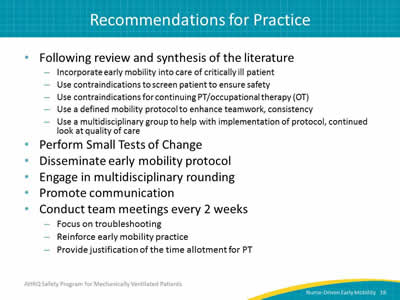
Say:
Studies indicate that it is important to incorporate early mobility into the care of critically ill patients, using contraindications to screen the patient to ensure that the patient is safe and for continuing physical and occupational therapy. The evidence from this research advocates the use of a multidisciplinary approach with a defined mobility protocol to enhance teamwork, consistency, and quality of care.
To begin incorporating an early mobility program, begin with Small Tests of Change. Start with one patient, being careful to select one who has a high likelihood of success. Once your protocol is clearly written and easily understood, and all stakeholders have received the necessary training or education, disseminate it to the various disciplines. During multidisciplinary rounding, discuss which patients are ready for early mobility and which are not. Improved communication during the rounding process, with the purposeful objective of getting the patient out of bed faster, will increase the probability of reaching your patient goals for the day.
Consider having a team meeting every 2 weeks to reinforce protocols, overcome barriers to implementation, and improve teamwork and communication. This will also give you an opportunity to discuss the physical therapy workload and if the time allotment is sufficient to mobilize patients or is in excess of what is needed.
Slide 19: What Was the Patient Experience Like?
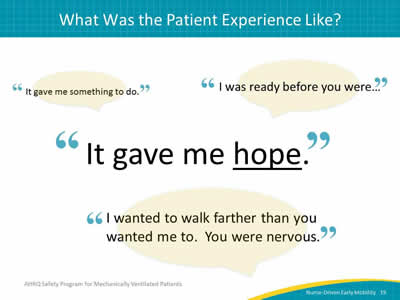
Say:
After you mobilize a patient, ask them what their experience was like and how they felt. You may hear responses such as: "I was ready before you were." "I wanted to walk further." "It gave me something to do." "It gave me hope that I would get better." Seeing your patient smile, having taken even one small step, will be an inspiration to you and your team.
Slide 20: Sustaining Practice Through Standardization
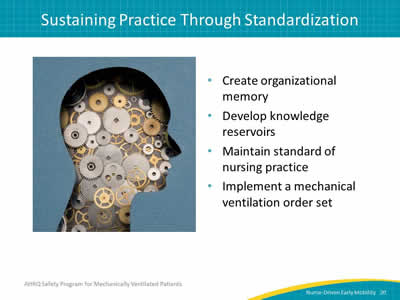
Say:
Sustaining practice is essential to maintaining early mobility protocol. Standardizing the use of early mobility for mechanically ventilated patients will help to create organizational memory, meaning that information and procedures will be collectively understood and remembered. Additionally, work to create "knowledge reservoirs" or repositories for maintaining standardized operations. Maintaining a high standard of nursing practice is paramount to sustain any hospital initiative, but it is especially important when working with patients in the ICU. Finally, having these protocols documented in the electronic medical records can make it more readily accessible and having mechanical ventilation order sets from physicians or other providers firmly in place will help sustain the practice of early mobility.
Slide 21: Measures for Sustainability
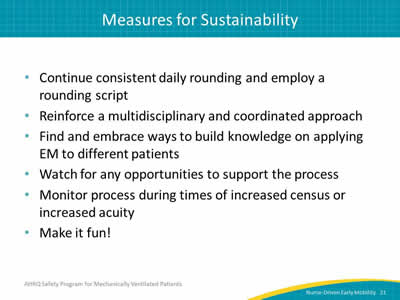
Ask:
How you are going to sustain the practice of early mobility in your unit?
Say:
Consider utilizing a rounding script during multidisciplinary rounds. Continue to build knowledge and application to different patients. Share and celebrate success stories of early mobilization of patients in your unit. See them as opportunities for education and a means to inspire your team to continue to improve teamwork and collaboration. Be aware of the busier times of increased census or increased acuity as it may impact your ability to act upon your early mobility protocol.
Slide 22: Continue the Sustainability Measures
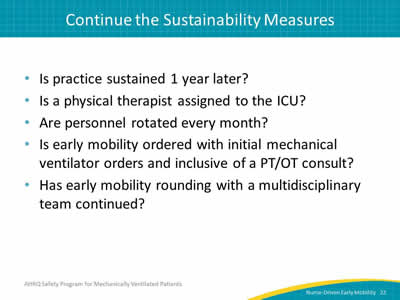
Say:
Evaluate your early mobility protocols in 1 year. Were they sustained? Is there a physical therapist assigned to the unit? Are personnel being rotated when needed? Is the early mobility order set in place for each mechanically ventilated patient? Has early mobility rounding with a multidisciplinary team been maintained? If you find the interventions you put in place have not been sustained, return to the guiding framework shown on slide 15 and determine why your goals became unsustainable, how they became unsustainable, and what your team can do to improve them to develop a successful model for sustaining a nurse-driven early mobility protocol in your unit.
Slide 23: Questions?
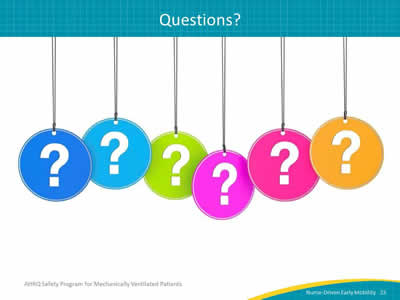
Ask:
Are there any questions?
Slide 24: References
